Advertisement
Advertisement
Advertisement
Advertisement
X-rays are high-energy particles of electromagnetic radiation Radiation Emission or propagation of acoustic waves (sound), electromagnetic energy waves (such as light; radio waves; gamma rays; or x-rays), or a stream of subatomic particles (such as electrons; neutrons; protons; or alpha particles). Osteosarcoma used in the medical field for the generation of anatomical images. X-rays are projected through the body of a patient and onto a film, and this technique is called conventional or projectional radiography. As radiation Radiation Emission or propagation of acoustic waves (sound), electromagnetic energy waves (such as light; radio waves; gamma rays; or x-rays), or a stream of subatomic particles (such as electrons; neutrons; protons; or alpha particles). Osteosarcoma by X-rays can cause adverse effects depending on the absorbed dose, it is necessary to take protective measures to reduce harm. Digital radiography uses the digital data format and allows for the digital manipulation of images. Common uses include evaluation of chest, mediastinal, spinal, and bone Bone Bone is a compact type of hardened connective tissue composed of bone cells, membranes, an extracellular mineralized matrix, and central bone marrow. The 2 primary types of bone are compact and spongy. Bones: Structure and Types/joint conditions. While radiography is still used to visualize head and abdominal structures, more advanced modalities (CT and MRI) are now preferred. Radiography remains an essential component of initial tests in many diseases, given its wide availability, low cost, and ease of operation.
Last updated: Mar 29, 2023
Advertisement
Advertisement
Advertisement
Advertisement
Advertisement
Advertisement
Advertisement
Advertisement
An X-ray X-ray Penetrating electromagnetic radiation emitted when the inner orbital electrons of an atom are excited and release radiant energy. X-ray wavelengths range from 1 pm to 10 nm. Hard x-rays are the higher energy, shorter wavelength x-rays. Soft x-rays or grenz rays are less energetic and longer in wavelength. The short wavelength end of the x-ray spectrum overlaps the gamma rays wavelength range. The distinction between gamma rays and x-rays is based on their radiation source. Pulmonary Function Tests is a discrete, high-energy particle of electromagnetic radiation Radiation Emission or propagation of acoustic waves (sound), electromagnetic energy waves (such as light; radio waves; gamma rays; or x-rays), or a stream of subatomic particles (such as electrons; neutrons; protons; or alpha particles). Osteosarcoma (photon) that propagates through space at the speed of light.

Diagram of an X-ray tube:
In the tube, electrons are accelerated toward a tungsten target (anode), which then decelerate after hitting the target, releasing heat and X-ray photons.
| Weeks post conception | Effects of major exposure |
|---|---|
| 2 |
|
| 3–5 |
|
| 6–13 |
|
| 14–23 |
|
| 24 weeks to term |
|
Order of producing an image with X-rays:
Technologies producing radiographic image:

Image of an early X-ray: X-ray of a left hand taken at a public lecture by Wilhelm Röntgen
Image: “An early X-ray” by Wilhelm Röntgen; current version created by Old Moonraker. License: Public DomainX-ray X-ray Penetrating electromagnetic radiation emitted when the inner orbital electrons of an atom are excited and release radiant energy. X-ray wavelengths range from 1 pm to 10 nm. Hard x-rays are the higher energy, shorter wavelength x-rays. Soft x-rays or grenz rays are less energetic and longer in wavelength. The short wavelength end of the x-ray spectrum overlaps the gamma rays wavelength range. The distinction between gamma rays and x-rays is based on their radiation source. Pulmonary Function Tests images of the chest can be produced in the following projections:

Chest radiograph projections
Image by Lecturio.
Posteroanterior (PA) X-ray projection:
The X-ray beam penetrates the patient from the posterior aspect, and the anterior aspect is placed in direct contact with the receptor.

Anteroposterior (AP) X-ray projection:
The X-ray beam penetrates the patient from the anterior aspect, and the posterior aspect is placed in direct contact with the receptor.

Apical lordotic X-ray projection:
The X-ray beam penetrates the patient at an angle to display 2 different elements at different levels.
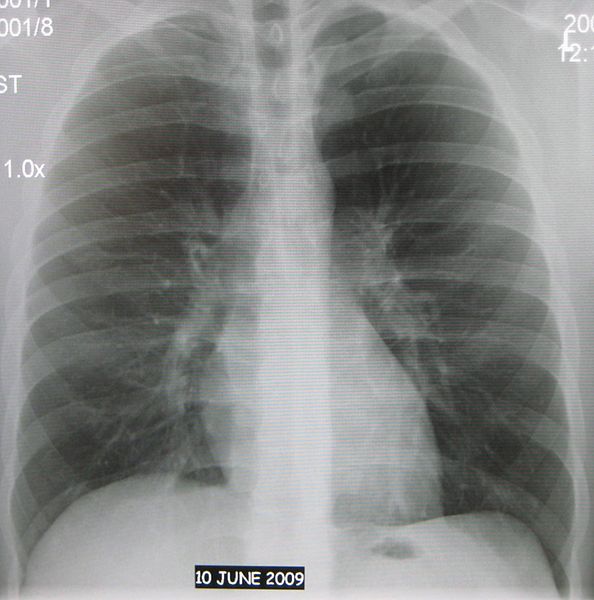
Normal chest X-ray
Image: “Normal AP chest X-ray” by James Heilman, MD. License: CC BY 3.0
Differences between anteroposterior (AP, left) and posteroanterior (PA, right) X-ray projections:
In the AP view, the structures that are further away from the cassette, such as the heart, are magnified.
To obtain an optimal anatomical image:
The following aspects reduce the quality Quality Activities and programs intended to assure or improve the quality of care in either a defined medical setting or a program. The concept includes the assessment or evaluation of the quality of care; identification of problems or shortcomings in the delivery of care; designing activities to overcome these deficiencies; and follow-up monitoring to ensure effectiveness of corrective steps. Quality Measurement and Improvement of the anatomical image:

Differences between an expiratory and an inspiratory chest X-ray:
Notice that in the inspiratory X-ray, the posterior ribs and the pulmonary parenchyma are more easily seen, whereas in the expiratory X-ray, the parenchyma looks hazy and lacks definition.
The quality Quality Activities and programs intended to assure or improve the quality of care in either a defined medical setting or a program. The concept includes the assessment or evaluation of the quality of care; identification of problems or shortcomings in the delivery of care; designing activities to overcome these deficiencies; and follow-up monitoring to ensure effectiveness of corrective steps. Quality Measurement and Improvement inspection Inspection Dermatologic Examination of the image must be included and should be done preferably before the following reading sequence:
The following elements should be checked for adequate placement:

X-ray of a patient with a tracheostomy tube
Image by Hetal Verma.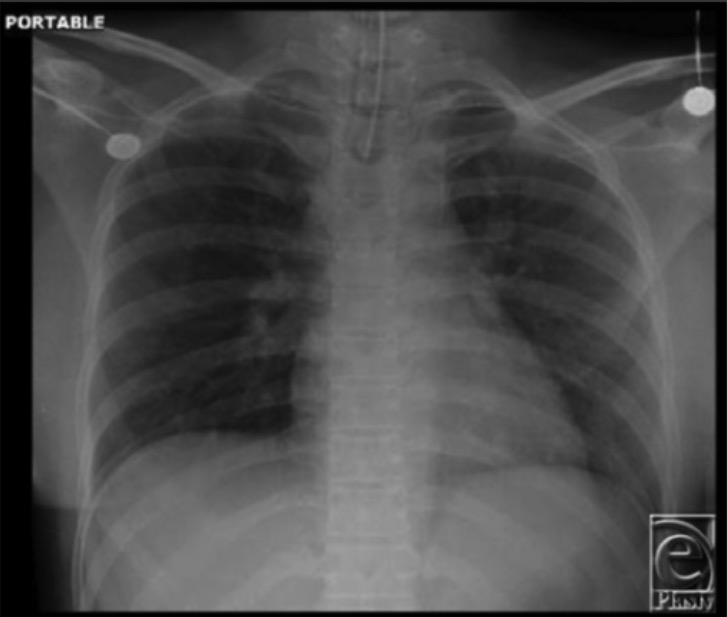
A chest X-ray showing correct endotracheal tube placement and no acute lung pathology
Image: “A chest X-ray showing correct endotracheal tube placement” by Department of Anesthesia, Rutgers New Jersey Medical School, Newark, NJ. License: CC BY 2.0
A chest X-ray of a patient with an implanted defibrillator with distal tip (thicker than a pacemaker) in the right ventricular apex (green marker)
Image by Hetal Verma.
Posteroanterior (PA) and lateral chest X-rays of a patient with an implanted pacemaker:
See the 2 leads extending into the heart. Also, see the 2 valvular replacements on the lateral view.
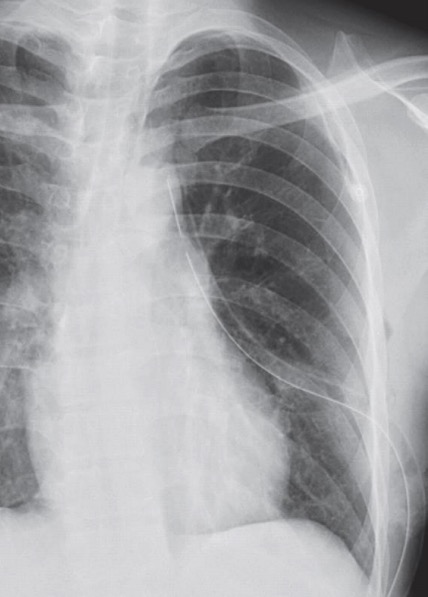
X-ray of a patient with a chest tube
Image by Hetal Verma.
X-ray of a patient with a Swan-Ganz catheter with the tip projecting over the distal pulmonary trunk/proximal right pulmonary artery
Image by Hetal Verma.
X-ray of a patient with a peripherally inserted central catheter
Image by Hetal Verma.
X-ray of a patient with a Port-A-Cath:
See its characteristic triangular end on the chest wall (green circle).

X-ray of a patient with a central line:
The line enters and runs through the internal jugular vein until it reaches the superior vena cava (green arrowhead).

X-ray of a patient with a Dobhoff tube:
Notice how the tube bends through the stomach to reach the duodenum and into the proximal jejunum near the ligament of Treitz.
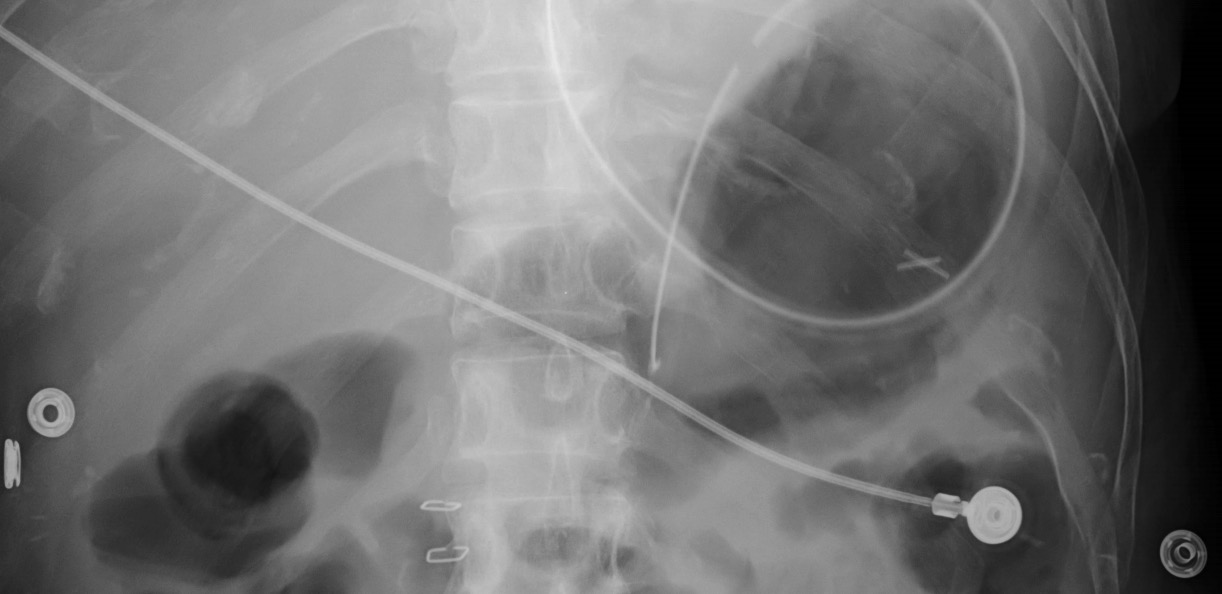
X-ray of a patient with a nasogastric tube:
Notice the tube coil within the stomach.
The following structures must be identified in a cephalocaudal manner and checked for abnormalities (e.g., cavitations, consolidations):
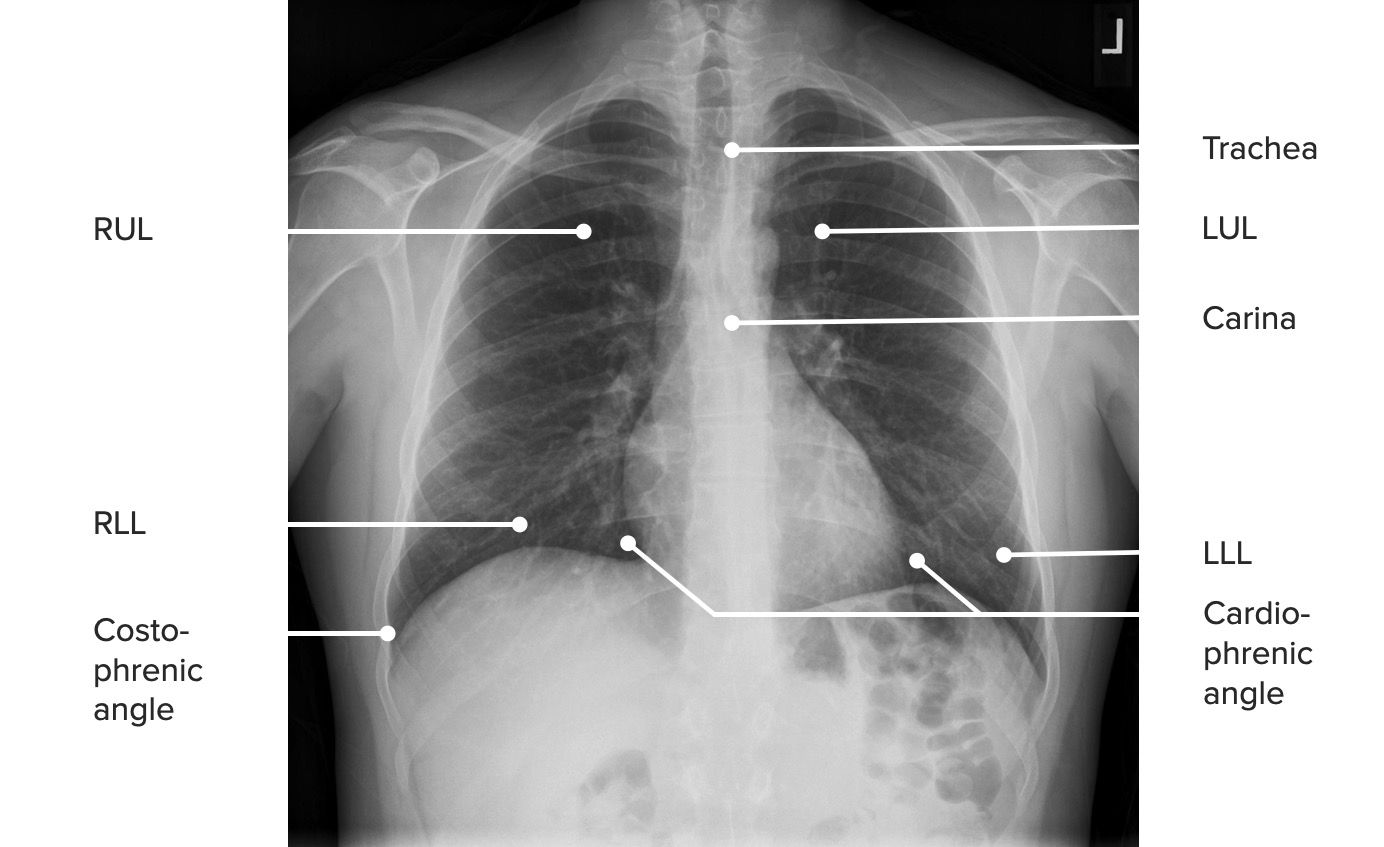
A posteroanterior (PA) projection of the chest identifying pulmonary structures and landmarks
RUL: right upper lobe
RLL: right lower lobe
LUL: left upper lobe
LLL: left lower lobe

A lateral projection of the chest identifying pulmonary structures and landmarks
Image by Hetal Verma.
A posteroanterior (PA) projection of the chest identifying the mediastinal structures
Image by Hetal Verma.
A lateral projection of the chest identifying the mediastinal structures
Image by Hetal Verma.The following structures must be identified in a cephalocaudal manner and checked for abnormalities (e.g., fractures):

A posteroanterior projection of the chest identifying the major bony structures of the chest and the main structures of the upper abdomen
Image by Hetal Verma.Abdominal X-rays have low sensitivity for evaluating solid organs, which is why they have been replaced by CT scans and ultrasound examination.
X-ray X-ray Penetrating electromagnetic radiation emitted when the inner orbital electrons of an atom are excited and release radiant energy. X-ray wavelengths range from 1 pm to 10 nm. Hard x-rays are the higher energy, shorter wavelength x-rays. Soft x-rays or grenz rays are less energetic and longer in wavelength. The short wavelength end of the x-ray spectrum overlaps the gamma rays wavelength range. The distinction between gamma rays and x-rays is based on their radiation source. Pulmonary Function Tests images of the abdomen can be produced in the following projections:

Abdominal X-ray showing an oval calculus projecting over the expected location of the right kidney/collecting system adjacent to the L3 transverse process
Image by Hetal Verma.The quality Quality Activities and programs intended to assure or improve the quality of care in either a defined medical setting or a program. The concept includes the assessment or evaluation of the quality of care; identification of problems or shortcomings in the delivery of care; designing activities to overcome these deficiencies; and follow-up monitoring to ensure effectiveness of corrective steps. Quality Measurement and Improvement inspection Inspection Dermatologic Examination of the image is done preferably before the reading sequence for abdominal X-rays:
Imaging of the spine Spine The human spine, or vertebral column, is the most important anatomical and functional axis of the human body. It consists of 7 cervical vertebrae, 12 thoracic vertebrae, and 5 lumbar vertebrae and is limited cranially by the skull and caudally by the sacrum. Vertebral Column: Anatomy and spinal cord Spinal cord The spinal cord is the major conduction pathway connecting the brain to the body; it is part of the CNS. In cross section, the spinal cord is divided into an H-shaped area of gray matter (consisting of synapsing neuronal cell bodies) and a surrounding area of white matter (consisting of ascending and descending tracts of myelinated axons). Spinal Cord: Anatomy using X-rays was widely used to study the contents of the cranial vault Cranial Vault Increased Intracranial Pressure (ICP) and the bones of the spine Spine The human spine, or vertebral column, is the most important anatomical and functional axis of the human body. It consists of 7 cervical vertebrae, 12 thoracic vertebrae, and 5 lumbar vertebrae and is limited cranially by the skull and caudally by the sacrum. Vertebral Column: Anatomy before the advent of CT and MRI.
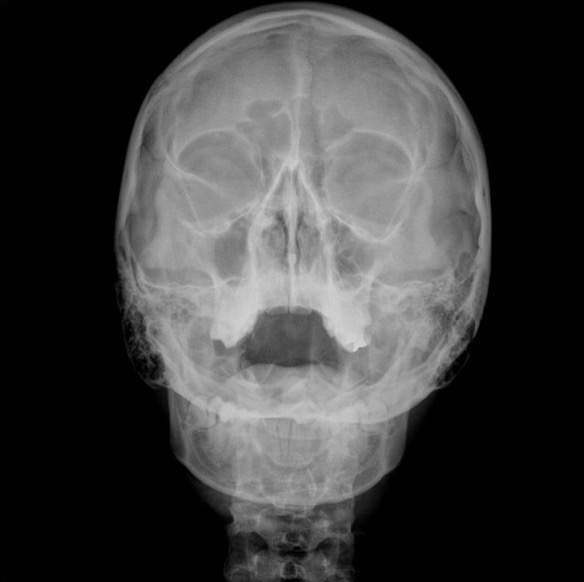
Waters’ view of the skull:
This particular patient shows diffuse prominent mucosal thickening in the right maxillary sinus and mild mucosal thickening in the left maxillary sinus.

Spinal X-ray showing vertebral lines
Image: “X-ray of vertebral lines” by Mikael Häggström. License: CC0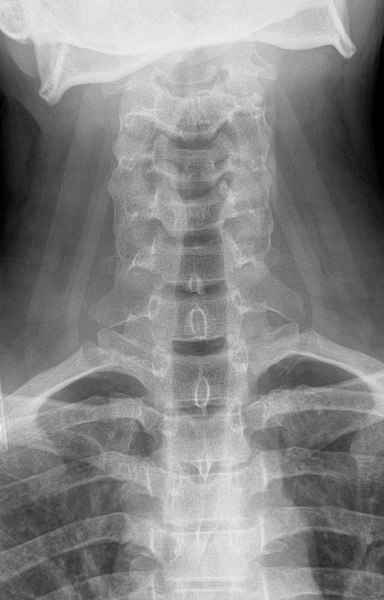
Posterior-anterior projection of the cervical spine
Image: “Projectional radiography” by Staff at the Department of Radiology, UC San Diego Health. License: Public Domain
A lateral projection of the cervical spine
Image: “Projectional radiography” by Staff at the Department of Radiology, UC San Diego Health. License: Public Domain
Posteroanterior (PA) and lateral chest X-rays of a patient with an implanted pacemaker:
Notice the 2 leads extending into the heart. Also, notice the 2 valvular replacements on the lateral view.

Open-mouth, or odontoid, projection of the cervical spine:
The white arrow is pointing to the odontoid process.
X-rays are used to assess the bones and joints of the extremities in suspected fractures, joint problems, and soft-tissue abnormalities ( inflammation Inflammation Inflammation is a complex set of responses to infection and injury involving leukocytes as the principal cellular mediators in the body’s defense against pathogenic organisms. Inflammation is also seen as a response to tissue injury in the process of wound healing. The 5 cardinal signs of inflammation are pain, heat, redness, swelling, and loss of function. Inflammation, edema Edema Edema is a condition in which excess serous fluid accumulates in the body cavity or interstitial space of connective tissues. Edema is a symptom observed in several medical conditions. It can be categorized into 2 types, namely, peripheral (in the extremities) and internal (in an organ or body cavity). Edema, or gas/ emphysema Emphysema Enlargement of air spaces distal to the terminal bronchioles where gas-exchange normally takes place. This is usually due to destruction of the alveolar wall. Pulmonary emphysema can be classified by the location and distribution of the lesions. Chronic Obstructive Pulmonary Disease (COPD), as seen in the cases of necrotizing fasciitis Necrotizing fasciitis Necrotizing fasciitis is a life-threatening infection that causes rapid destruction and necrosis of the fascia and subcutaneous tissues. Patients may present with significant pain out of proportion to the presenting symptoms and rapidly progressive erythema of the affected area. Necrotizing Fasciitis).
The following joints are commonly studied using conventional radiography:

Lateral (left) and anteroposterior (AP, right) projections of a normal elbow
Left: Image: “X-ray of normal hand by dorsoplantar projection” by Mikael Häggström. License: CC0
Lateral projection of a right foot and ankle
Image: “X-ray of normal right foot by lateral projection” by Mikael Häggström. License: CC0
Mortise (left), lateral (middle), and anterior-posterior view (right) of a normal right ankle
Left: Image: “X-ray of normal ankle – 15 degrees internal rotation” by Mikael Häggström. License: CC0
Anterior-posterior (left) and lateral (right) projection of a normal right knee
Left: Image: “X-ray of a normal knee by anteroposterior projection” by Mikael Häggström. License: CC0
Posteroanterior (left) and lateral (right) projections of a normal left wrist
Left: Image: “X-ray of normal wrist by dorsoplantar projection (crop)” by Mikael Häggström. License: CC0
Posteroanterior (left) and lateral (right) projections of a normal left hand and wrist
Left: Image: “X-ray of normal hand by dorsoplantar projection” by Mikael Häggström. License: CC0The diagnosis of fractures can be made based on an X-ray X-ray Penetrating electromagnetic radiation emitted when the inner orbital electrons of an atom are excited and release radiant energy. X-ray wavelengths range from 1 pm to 10 nm. Hard x-rays are the higher energy, shorter wavelength x-rays. Soft x-rays or grenz rays are less energetic and longer in wavelength. The short wavelength end of the x-ray spectrum overlaps the gamma rays wavelength range. The distinction between gamma rays and x-rays is based on their radiation source. Pulmonary Function Tests of the affected limb or joint, usually utilizing 2 or more projections:

X-ray of a separated acromioclavicular joint (gray arrow)
Image: “AC Separation XRAY (enhanced)” by Root4(one). License: CC BY 2.5